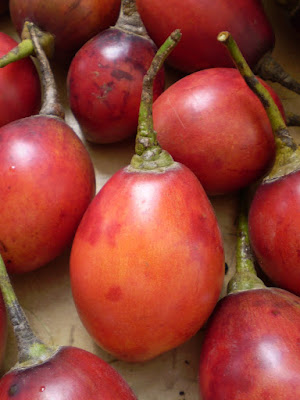Albeit a very small Tamarillo fruit, it is a massive leap of confidence & i won't bin this year's trees after all.
Tamarillos are native to the Andes in South America but can be grown in many subtropical regions around the world. Prior to 1967, the Tamarillo was known as the "tree tomato" in New Zealand, but a new name was chosen by the New Zealand Tree Tomato Promotions Council in order to distinguish it from the ordinary garden tomato and increase its exotic appeal. The choice is variously explained by similarity to the word "tomato", the Spanish word "amarillo", meaning yellow, and a variation on the Maori word "tama", for "son or boy". They are a popular tree grown in NZ home gardens and will often be seen in supermarkets during the season.
The plant is a fast-growing tree that grows up to 5 meters. Peak production is reached after 4 years, and the life expectancy is about 12 years. The tree usually forms a single upright trunk with lateral branches. The flowers and fruits hang from the lateral branches. The leaves are large, simple and perennial, and have a strong pungent smell. The flowers are pink-white, and form clusters of around 10 flowers. They produce 1 to 6 fruits per cluster. Plants can set fruit without cross-pollination, but the flowers are fragrant and attract insects. Cross-pollination seems to improve fruit set. The roots are shallow and not very pronounced, therefore the plant is not tolerant to drought stress, and can be damaged by strong winds.
The fruits are egg shaped and about 4-10cm long. Their colour varies from yellow and orange to red and almost purple. Sometimes they have dark, longitudinal stripes. Red fruits are more acidic, yellow and orange fruits are sweeter. The red and purple types of fruits are preferred even though they taste more acidic, their colour is preferred by consumers. The flesh has a firm texture and contains more and larger seeds than a common tomato. The fruits are very high in vitamins and iron and low in calories.
The flesh of the tamarillo is tangy and variably sweet, with a bold and complex flavor, and may be compared to kiwifruit, tomato, guava, or passion fruit. The fruit is eaten by scooping the flesh from a halved fruit. Some people in New Zealand cut the fruit in half, scoop out the pulpy flesh, sprinkle lightly sugared and add to cereal at breakfast. Yellow-fruited cultivars have a sweeter flavor, occasionally compared to mango or apricot. The red-fruited variety, which is much more widely cultivated, is more tart, and the savory aftertaste is far more pronounced. In New Zealand, Tamarillos fruit around October. The skin and the flesh near it have a bitter taste and are not usually eaten raw.






No comments:
Post a Comment